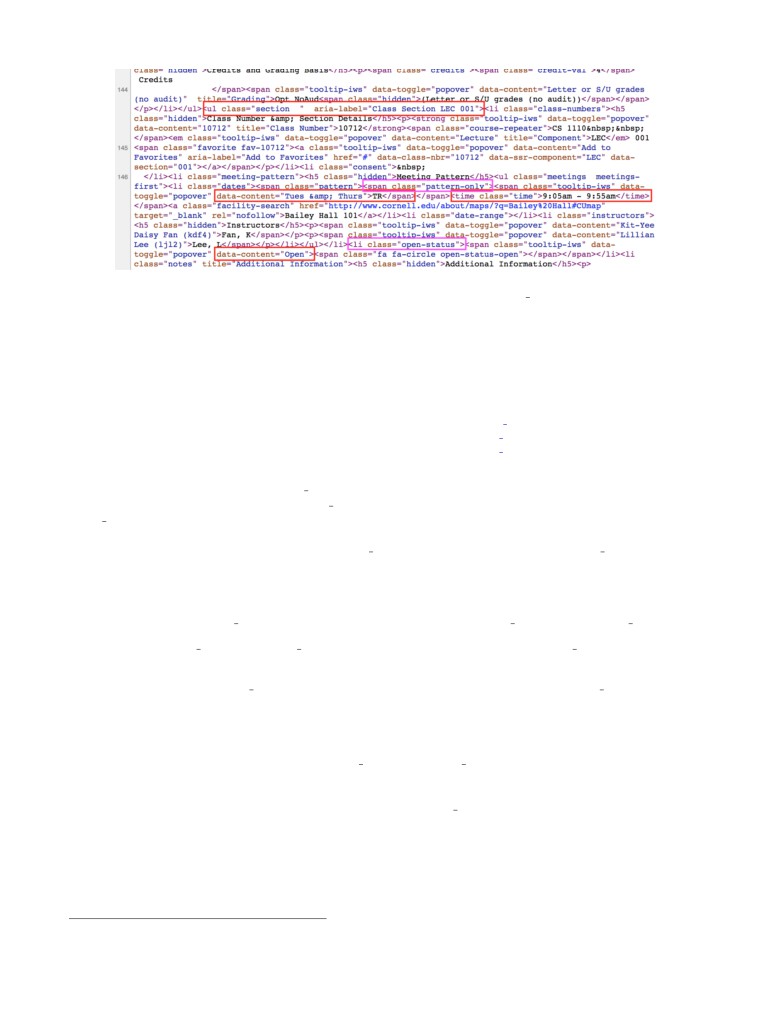CS 1110 Spring 2020, Assignment 1: Write your own CourseGrab
(Get open/closed/waitlist status from the registrar’s live webpages)
Updates:
• Tuesday Feb 11, 9:30am: A1 file a1 first.py, typo in test after() test case #10: it was missing the second
argument in the call to assert equals
• Mon Feb 10, 7pm: third precondition added to first between in a1 second.py; see page 6.
• Sun Feb 9, 6:29pm: A1 file a1 first.py, had a typo in test after() test case #5: it was missing the line
testcase.assert equals(’ A ’, result) at the end.
The online files have been updated, but if you had already started working on them, do not re-download them: don’t
risk over-writing the work you already did!
CS 1110 Spring 2020, Assignment 1: Write your own CourseGrab
(Get open/closed/waitlist status from the registrar’s live webpages)∗†
Navigating links in this pdf. Text in any shade of blue in this document is a click-able link.
Contents
1
Rules
1
1.1
How To Register a Partner (You Only Get One)
1
1.2
What Collaborations Are (Dis-)Allowed And How To Document Them
2
1.3
Python You Are NOT Allowed To Use In This Assignment
2
2
Deadlines
2
2.1
Is there going to be a chance to revise in response to grader feedback?
2
3
Task Overview: Extracting Roster Information
3
3.1
What we provide
5
3.1.1
Files description
5
3.1.2
Call structure
5
3.2
Your task: the short version
5
4
Iterative Development (How to Work Through the Assignment)
5
5
Grand Finale
8
6
Code Cleanup
8
7
Pre-Submission Checklist and What to Submit
8
1
Rules
1.1
How To Register a Partner (You Only Get One)
You may work alone or with exactly one other person.
If you are partnering, the two of you must form a group on the CS1110
course management system
CMS BEFORE submitting, which will link your submission “portals”. More details are in Section 2.
scenario”.
∗Authors: Lillian Lee, with some instructions derived from previous assignments by Walker White and David Gries and formatting
initially created by Stephen McDowell.
†Assignments will be motivated by real-life use-cases, such as students wanting to know whether a lecture or section opens up. We
admit that we had wanted A1 to involve Iowa Caucus results as a current-events application of your newly acquired Python skills, but
alas, that didn’t work out, slightly delaying release of this assignment.
1
1.2
What Collaborations Are (Dis-)Allowed And How To Document Them
means you and, if there is one, your one CMS-registered group partner,
1. Never look at, access or possess any portion of another group’s code in any form. (This includes code written
on a whiteboard.)
2. Never show or share any portion of your code in any form to anyone except a member of the course staff.
3. Never request solutions from outside sources, for example, on online services like StackOverflow.
4. DO specifically acknowledge by name all help you received, whether or not it was “legal” according to (1)-(3).
Rule (4) means “cite your sources”: the header comments of your code must accurately describe the entire set of
people and sources1 that contributed to the code that is submitted.
Example:2
# a1_second.py
# KDF4 and LJL2
# Sources/people consulted: discussed strategy for after() with Walker White
# Feb 12, 2020
1.3
Python You Are NOT Allowed To Use In This Assignment
You may not use, and do not need, any Python constructs not yet covered by the labs, lectures, or posted lecture
slides by the time this assignment was released.3 We want you to demonstrate your skills with the Python we have
taught so far.
2
Deadlines
There are several deadlines on Wednesday, February 19.
• By 2pm on Wednesday, February 19, submit whatever you have done at that point to CMS , following steps
is OK if you haven’t finished yet; CMS lets you update submissions until the final deadline.
• By 11:59pm on Wednesday, February 19, make your final files submission on CMS , once again following the
The 2pm checkpoint on Wednesday, February 19 provides you a chance to alert us during business hours if any
problems arise. Since you’ve been warned to submit early, do not expect that we will accept work that doesn’t make
it onto CMS on time, for whatever reason, including server delays stemming from many other students trying to
submit at the same time as you.4
Of course, if some special circumstances arise, contact the instructor(s) immediately.
2.1
Is there going to be a chance to revise in response to grader feedback?
Stay focused on hitting the deadlines listed above. Later, we’ll talk again.
1Other than the course staff or course materials.
2We aren’t asking for your names, on the principle that grading an assignment shouldn’t require knowing the identity of the author(s).
But we do want to have NetID identifiers so we don’t get confused when grading many files at once.
3So, no ifs, no loops, etc., even if for some reason you know what those are.
4There are no so-called “slipdays” and there is no “you get to submit late at the price of a late penalty” policy.
2
3
Task Overview: Extracting Roster Information
you can see which course’s lectures and sections are open, closed, waitlisted, and so on, but it would be nice to have
a more efficient way to look up such information and a more compact presentation.
In this assignment, you’ll write functions called by a function we created that pulls such information from the
online course roster. When done, you’ll be able to run the program get components.py5 on live Cornell Spring 2020
roster pages to have interactions like what’s shown on the next page.6
5Lectures, sections, and labs are “components” in registrar-speak.
6So, when you complete this assignment, you might want to check whether the final output you get matches what’s shown in this
document.
3
(base) llee@ushuaia: ~/cs1110/2020sp/a1 > python get_components.py
Enter a subject rubric, such as "CS" or "AEM", to look up in the Spring 2020 roster
(just hit return for "CS"): CS
The webpage for CS Spring 2020 has been loaded.
Note that this program does NOT refresh its data;
if the webpage gets updated, you'll need to restart this program to get the
new
info.
Enter the class number for subject CS, such as 1110, or "q" to quit:
1110
Here are all components whose times I found (there may
not
be
any).
LEC 001 TR 9:05am - 9:55am Open
DIS 201 T 10:10am - 11:00am Closed
DIS 202 T 11:15am - 12:05pm Open
DIS 203 T 12:20pm - 1:10pm Open
DIS 204 T 1:25pm - 2:15pm Closed
DIS 205 T 2:30pm - 3:20pm Open
DIS 206 T 3:35pm - 4:25pm Open
DIS 207 W 10:10am - 11:00am Open
DIS 208 W 11:15am - 12:05pm Closed
DIS 209 W 12:20pm - 1:10pm Open
DIS 210 W 1:25pm - 2:15pm Open
DIS 211 W 2:30pm - 3:20pm Open
DIS 212 W 3:35pm - 4:25pm Open
DIS 213 T 12:20pm - 1:10pm Open
DIS 214 T 1:25pm - 2:15pm Closed
DIS 215 W 12:20pm - 1:10pm Open
DIS 216 W 1:25pm - 2:15pm Open
Enter another course number, or "q" to quit:
1112
Here are all components whose times I found (there may
not
be
any).
LEC 001 TR 11:15am - 12:05pm Open
DIS 201 T 12:20pm - 1:10pm Open
DIS 202 T 1:25pm - 2:15pm Open
DIS 203 T 2:30pm - 3:30pm Open
DIS 205 W 10:10am - 11:00am Open
DIS 206 W 11:15am - 12:05pm Open
DIS 207 W 12:20pm - 1:10pm Open
DIS 208 W 1:25pm - 2:15pm Open
DIS 209 W 2:30pm - 3:20pm Open
Enter another course number, or "q" to quit: q
(base) llee@ushuaia: ~/cs1110/2020sp/a1 >
The key to this process is that many webpages are really just big collections of special strings that your browser
displays using formatting information in those strings. You can view the underlying string for a given webpage by
using the “view source” functionality of your browser.7 Here is an excerpt of the source (underlying string) for the
webpage above:
7Chrome: View Developer View Source . Firefox: Tools Web Developer Page Source . Safari: Develop Show Page Source . Or, right-click
or ctrl-click in the browser window often brings up a menu with an option to view page source.
4
We’ve highlighted with red boxes the locations of the information needed by get components.py. The “label” for
the main lecture is in the class="section " box. The meeting days are in the data-content box following the
magenta class="pattern-only" box.8 And so on.
3.1
What we provide
3.1.1
Files description
Create a new directory on your computer. Download the following into that new directory.
We’ve written the entire program get components.py for you! But it won’t work as expected yet, because it
makes calls to an unfinished function in file a1 second.py.
a1 second.py is a “skeleton” containing the function-definition headers and docstring specifications you’ll need
— don’t change those — but with the function bodies consisting only of the do-nothing command pass.
We’ve also given you a partially-completed file a1 first.py for testing the functions in a1 second.py. It has
some purposely erroneous test cases in it; more on that later.
3.1.2
Call structure
• The program in file get components.py repeatedly calls function report section() in file a1 second.py.
• Function report section() in a1 second.py should call “helper” function first between()9 which itself
should call after().
• The testing functions in a1 first.py should each call the corresponding functions from a1 second.py multiple
times.
3.2
Your task: the short version
In a nutshell, you must fix and complete files a1 first.py and a1 second.py, following all directions given in
comments prefaced with the all-caps word “STUDENTS” as well as in this document.
You are allowed to write your own helper functions, but if you do, you must (a) provide clear specification
docstrings for them, and (b) provide adequate testing for them in a1 first.py
4
Iterative Development (How to Work Through the Assignment)
As outlined in Section 3.1.2, there are dependencies between the functions you will write. The wisest course of action
is to work on the basic functions first, and make sure they are correct, before moving on to the functions that build
on that basis.
8We need the magenta info because there are a number of occurrences of data-context elsewhere in the excerpt shown.
9In fact, we are expecting it to do so multiple times.
5
Hence, develop and test the functions in a1 second.py one at a time, in order. For each function, do
the following.
1.
Carefully read the specification for the function.1011
def after(text, tag):
"""Returns: the part of `text` just after at the 1st occurrence of `tag`.
Preconditions:
`text` [str]: contains at least one instance of `tag`
`tag`
[str]: length > 0
Examples:
after('start <a id="c111"> this that', '<a id="c111">')
--> ' this that'
(Note the single space at the beginning.)
after('start <a id="c111"> this that the other', 'other')
--> ''
"""
Mon, Feb 10, 7pm: third precondition added
def first_between(text, start_str, end_str):
"""Returns substring of `text` occurring between the 1st occurrence of
`start_str` and the first following occurrence of `end_str`.
Preconditions:
`text` [str]: length > 0.
`start_str` and `end_str` [str]: both non-empty and occur in `text`.
At least one `end_str` appears after a `start_str` in `text`.
Examples:
first_between('A1A2A3bA4ccccA5', 'A', 'b') ---> '1A2A3'
first_between('hi)bye(x)(a+b)', '(', ')')
--> 'x'
(Note that there was an end_str before start_str.)
first_between('<a href="x">yes</a><span>toodles</span>', '<span>', '<')
--> 'toodles'
"""
10This step makes sure you know what a function is supposed to do. You don’t get points for writing correct code for the wrong task!
11 Backquotes are used to visually distinguish variable names, like this: `tag`. We’re not using angle brackets (as in lecture) because
we’ll be working with html strings, which themselves contain angle brackets.
6
def report_section(s):
"""Returns string '<component> <meeting day(s)> <time> <status>'.
Preconditions:
`s` corresponds to a single class component (=lecture/section)
that isn't TBA, having a pattern like this
'<ul class="section ... aria-label="Class Section DIS 202"
... class="pattern-only"><span ...>T</span>
... class="time">11:15am - 12:05pm</time>
... <li class="open-status"> ... data-content="Open"...'
where the following substrings occur exactly once:
'<ul class="section'
'class="pattern-only"><span'
'class="time">'
<li class="open-status">
For this example, this function returns 'DIS 202 T 11:15am - 12:05pm Open'.
"""
2.
Look at the test cases in a1 first.py and fix the bad ones.1213
Function test after() contains at least two bad test cases.14
• For a test case where the “expected answer” is wrong, add the comment # ... STUDENT-FIXED ERROR
... under the comment that numbers the test case; comment out the incorrect assert equals call; and
add the fixed call below, like this:
# 0. tag at beginning
# ... STUDENT-FIXED ERROR ...
<--- added
result = a1_second.after('sta', 'st')
# testcase.assert_equals('', result)
<--- commented out
testcase.assert_equals('a', result)
<--- fix added
• For a test case where the situation should not have been tested, add the comment # ... STUDENT-DELETED
CASE ... under the comment that numbers the test case; add a comment giving your reasoning, and
comment out the entire test case, like this:
# 1110. tag is an int
# ... STUDENT-DELETED CASE ...
<--- added
# ... REASON: violates precondition
<--- added
# result = a1_second.after('123', 2)
<--- commented out
# testcase.assert_equals('3', result)
<--- commented out
3. Add missing representative test cases for that function in the appropriate place in test after()
and test first between().15 You want cases that represent valid inputs, but exhibit different aspects of the
problem the function is trying to solve, so that using your suite of test cases can catch different types of bugs.
For each test case you add, include in a comment a short justification of what the test case represents.
12We want to make sure you examine and understand test cases — and thus, the specifications of the functions they are testing —
even though we just introduced unit tests in Lecture 6. To this end, we are not only supplying you with a number of test cases, so you
have many examples to look at; but purposely introducing some erroneous ones to force you to examine them carefully.
13We guarantee that there are no (intentional) errors in the “expected answers” in test first between or test report section.
14Just to be clear: maybe there are just two, maybe there are three, maybe there are more. . .
15We have constructed enough test cases for you for test report section(), so you don’t need to add any more. You’re welcome.
7
4. Write the function body in a1 second.py161718
5. Run python on the script a1 first.py.19 If errors are revealed with the function you’re currently working
on, fix them and re-test.
5
Grand Finale
If you’re convinced that your code is correct, you should be able to run Python on the file get components.py20
and reproduce the interaction in Section 3.
6
Code Cleanup
Before submitting, ensure your code obeys the following.21
• Lines are short enough (˜80 characters) that horizontal scrolling is not necessary.
• You have indented with spaces, not tabs
• Functions are separated from each other by at least two blank lines.
• You have removed any debugging print statements.
• You have removed all pass statements.
• You have removed “instruction” comments, such as “# IMPLEMENT THIS FUNCTION”.
• If you added any helper functions, these have good docstring specifications and you have put sufficient testing
code for your functions in a1 second.py .
7
Pre-Submission Checklist and What to Submit
Make sure the following are all true before you submit.
1. You’ve changed the header comments in all files to list the entire set of people and sources that contributed to
the code.
2. You (and your partner) have included your NetIDs in the header of all files.
3. The date in the header comments has been changed to when the files were last edited.
invitations.
5.
(reminder) If working with a partner, you have grouped on CMS. (One has invited on CMS, and one has
accepted on CMS.)
16Hint: If the specification says to return something, you need a return statement returning something of the correct type.
17Another hint: double-check that if the instructions said to call a certain helper, that you did indeed use that helper function.
18Also: the functions in get components.py do some string processing, so you may find it useful to look in that file for inspira-
tion/examples. But it is definitely not necessary to do so, and if you do choose to check that file out, don’t be intimidated by the Python
in there that you don’t know (yet).
19At the command prompt, not the >>> Python interactive prompt, enter python a1 first.py .
20At the command-shell prompt, enter python get components.py .
21These requirements up speed up the process of reading/grading hundreds of files.
22Do not submit any files with the extension/suffix .pyc. It will help to set the preferences in your operating system so that extensions
always appear.
8








